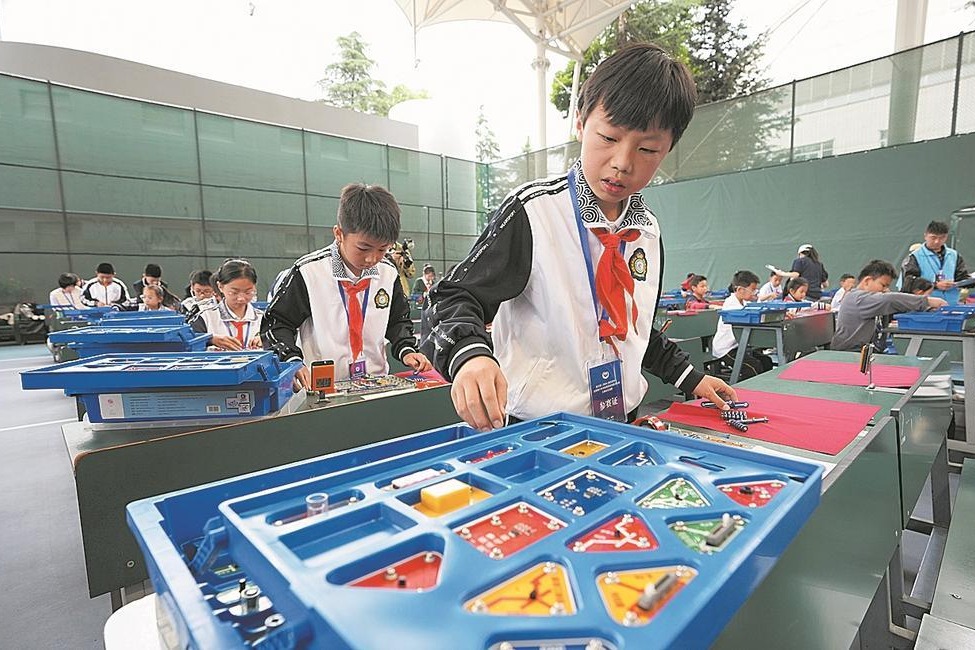Time tells the truth

| Hei Ming shows pictures from his collection Memories of Tian'anmen Square at the exhibition in EMGdotART, Guangzhou. Zou Zhongpin / China Daily |
| A 1970 picture of four girls, each holding a small red book of Chairman Mao Zedong, in Tian'anmen Square. |
Hei Ming writes the history of nameless soldiers who sacrificed for China in the War of Resistance against Japanese Aggression - and others whom time has forgotten
Hei Ming was astonished by what he saw on his visit to the Normandy American Cemetery in France last year: Rows of white granite headstones, a cross or Star of David, flush with the vast grassland facing Omaha Beach, the scene of D-Day (June 6, 1944) during World War II.
The headstones commemorate 9,387 American soldiers, most of whom lost their lives in the D-Day landings and ensuing operations. Engraved on each of the headstones is the person's name, rank, troop number, hometown and the date of death.
On the Walls of the Missing are inscribed 1,557 names. Rosettes mark the names of those since recovered and identified.
"In sharp contrast, we only have monuments in China to pay tribute to the military dead in the country's War of Resistance against Japanese Aggression (1937-45) - as a group. We may know how many soldiers died in the war, but we don't know who they are," says Hei, a documentary photographer who won the Golden Statue Award for China Photography, twice. His works have been exhibited overseas in such places as the National Library of France and the United Nations' headquarters.
"The war is a major event in our nation's history. Those who risked their lives to participate in this war are selfless heroes. Their names and stories deserve to be remembered."
The photographer is trying to write these unknown heroes into history with his photography and words. He has been traveling across the country since 2012 to interview survivors who are now living in the mainland and Taiwan. He plans to publish a book next year, which will include 100 veterans' wartime recollections and post-war experiences and photos illustrating what their lives are like now.
He recalls a long chat with a 91-year-old monk in Hunan province who was in the bloody Battle of Changde in 1943 and was one of just three survivors in his regiment. The interview lasted three days.
However, few smiling faces can be seen in Hei's photos of the veterans. Instead there are many lonely, stooped silhouettes in dilapidated houses.
"In particular, Kuomintang veterans who didn't leave the mainland for Taiwan before 1949 used to struggle to gain recognition of their contributions to the resistance against Japanese invaders. Some were treated badly during the political movements in the three decades following the country's founding, labeled 'counter-revolutionaries' and even jailed," Hei says.
Besides veterans, Hei has also zoomed in on social groups, including those intellectuals who were labeled as "rightists" in the Anti-Rightist Movement (1957-59); and those educated young people who, from the 1950s until the end of the "cultural revolution" (1966-76), were sent to rural areas to live and work.
"What these intellectuals, educated young people and veterans have in common is that many ended up in difficulties despite their hard work," Hei says.
"I hope my photography and writing can arouse public attention about these groups' circumstances and help improve their lives."
It gives Hei a strong sense of achievement to see impoverished interviewees receive donations for their hospital bills or job offers after people see his photos.
"My photography is not the kind of art that belongs to just a small circle. I don't want to indulge in self-admiration of my photos at home together with a few friends," Hei says.
"I'm presenting life and social changes through my photos and I want to get my observations across to the masses."
The 49-year-old has published more than 20 photo collections, most of them about "people": 100 farmers, 100 Shaolin monks, 100 Tibetan people, and 100 inhabitants of border areas.
Hei says his choice of subject is born out of his curiosity, but it always turns out to be of public concern as well.
He says he lived at Shaolin Temple because he wanted to know whether it's true that monks don't eat meat. Of course, he was also able to offer readers of his book, Shaolin Monks, an honest exploration of Buddhism in China.
He went to the small village of Xinyaozi in his childhood province of Shaanxi more than 30 times, from 1996 to 2004, to create a book about the transformation of the 100-year-old village. Bumpy journeys on tractors and sleeping in a cold, deserted room didn't bother him. The Beijing-based photographer enjoyed the escape from city life and made good friends with the simple, honest villagers.
Hei's focus on people comes from his belief that "historical changes and the characteristics of an age can best be reflected in people rather than natural scenery."
This is true in Hei's latest publication, Memories of Tian'anmen Square.
He invited people from across the country who took a photo in Tian'anmen Square, from 1949, when the republic was founded, to the 1990s, to Beijing and took new photos of them, from 2004 to 2009. They stood in the same place and struck the same pose as they had done decades ago.
While time hasn't washed away the magnificence of Tian'anmen Rostrum, it grayed the hair of a young man and took away his mother, who was beside him in their photo taken in 1969. In the photo Hei took of the man in 2009, there is just an empty chair next to him.
"People's appearances have changed, but more importantly, their inner mindsets have also undergone transformation. They become more relaxed and free as the country develops," Hei writes in the book's preface.
Hei's book is not only a collection of memories of 316 people, but also a showcase of China's development in the past 60 years, which is "the collective memory of Chinese citizens".
Chen Xiaobo, a photo critic and the chief photo editor of Xinhua News Agency, praises Hei as a "persistent rescuer of historical memories".
"Hei Ming is one of those who believe in and act according to the principle that each person's fate is worth recording and each endeavor to resist forgetting about history deserves respect."
xujingxi@chinadaily.com.cn
(China Daily 05/17/2013 page23)
Today's Top News
- House committee's report not conducive to steadying Sino-US economic and trade ties: China Daily editorial
- Unified national market resilience reinforcer: China Daily editorial
- Huge potential seen in China-Northern Ireland trade and investment cooperation
- Xi encourages young sinologists to bridge China, the world
- Xi, president of Comoros exchange congratulations on 50th anniversary of ties
- Luxury leasing market gains traction in HK
































